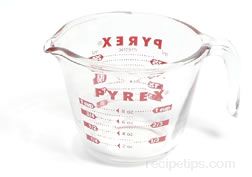|
Individual graduated dry measuring cups are used to measure large quantities of flour while measuring spoons can be used to measure the smallest quantities.
 
When measuring flour, it is best to fill the measuring device until the flour is heaping above the rim. Using the back edge of a knife or other straight edged object, create a precise measurement by running the straight edge along the rim of the measuring container to push off the excess flour.

It may be beneficial to stir the flour before measuring to remove any lumps that may have developed. The flour can also be sifted to insure that it is free of lumps, but this usually is not required because most brands of all-purpose flour are presifted. | 
